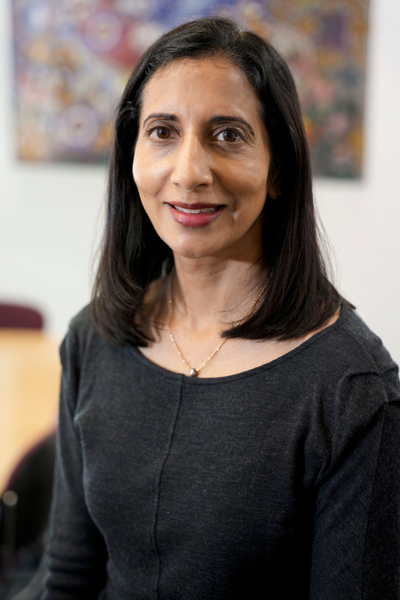- Foreword
- Message from Board Chair & Chief Executive
- 2023 Clinical Research Fellowships
- A message from the RBWH Foundation
- A message from The Common Good
- Metro North Research Excellence Awards
- Research stories
- ICU of the Future
- New approach ruling out pulmonary embolism
- Improving access to healthcare in the prison environment
- Safety and efficacy of peripheral versus centrally administered vasopressor infusion
- COVID-19 learnings set to inform future policy
- Telomere study could provide key to treating debilitating lung disease
- Productive Ward – Releasing time to care
- Brain organoids to revolutionise epilepsy treatment
- Reducing weight stigma in maternity care
- Parkinson’s Disease Check-In program giving people a voice
- Trial brings new treatment for common heart condition
- Teledentistry study shows promise in residential aged care
- Research fellow to boost Oral Health evidence-based care
- Study explores best approach to surgery for painful shoulder osteoarthritis
- The development and pilot testing of a stroke telerehabilitation decision toolkit
- Metro North Health delivers world-first breast scaffold surgery
- Regenerative jawbone hard at work care of collaborative Metro North Health approach
- Jamieson Trauma Institute leads e-scooter and e-bike injury research to drive community safety
- Forgotten fathers in pregnancy and obstetrics
- Putting the Spotlight on nursing and midwifery research
- Improving the health self-efficacy of stroke survivors
Brain organoids to revolutionise epilepsy treatment

Dr Lata Vadlamudi is working to improve epilepsy treatment for patients
Researchers at the Royal Brisbane and Women’s Hospital (RBWH) and the University of Queensland (UQ) are trialing a new technology to help epilepsy patients find the best treatment for their condition sooner.
One in 26 Australians will develop epilepsy in their lifetime and more than 30 per cent of these people do not respond to anti-seizure medications. Often, the journey to find a medication or combination of medications that successfully control an individual’s seizures can take many years of trial and error.
Despite more than 15 new anti-seizure medications becoming available in the past 30 years, the situation has not improved. Epilepsy specialists have identified an urgent need to find a new approach so appropriate treatment for patients can be found faster and with more precision.
Stem cell biologists and clinical researchers from RBWH and UQ are working together and using cutting edge technologies to grow human stem cells from drug-resistant epilepsy patients into brain organoids in the lab. The researchers have identified that they can detect changes in brain electrical activity with anti-seizure medication and next plan to test different anti-seizure medications on the organoids to see if these cells mirror how patients react to the medications. If successful, it will revolutionise the way drugs are selected for epilepsy patients.
RBWH Neurology Senior Staff Specialist and University of Queensland Neurosciences Theme Leader Associate Professor Lata Vadlamudi said ongoing seizures have a huge impact on quality of life for patients.
“The prospect of shortening the tumultuous journey many epilepsy patients must undertake to find the right medication is incredibly exciting,” Assoc Prof Vadlamudi said.
“For some patients, the process of finding a medication that works can be a rollercoaster, trialling drug after drug in the hope of improving their seizures. There is disappointment and distress each time a drug fails to improve their condition, as well as potential side-effects with each drug trialled.
“This can have an enormous toll on patients’ physical and psychological condition, resulting in a reduced quality of life and increased risk of sudden unexpected death associated with epilepsy. We are optimistic our research will result in a major step forward in epilepsy treatment.”
UQ’s Australian Institute for Bioengineering and Nanotechnology Professor Ernst Wolvetang said the organoids are usually created using skin or hair cell follicles from the epilepsy patient and cultivated in the lab for around six months.
“Stem cells emerge through this cultivation which can be harvested and if done correctly can grow to become three dimensional structures which mimic our organs,” Prof Wolvetang said.
“We are at the point now where we can create organoids for different organs and connect them, just as they would connect in the human body. The possibilities this research could lead to in the future are limitless.”
RBWH patient Aaron Reed, 38, has experienced firsthand the difficulties associated with finding the right medication to control his epilepsy seizures.
“I was diagnosed with epilepsy at aged 11 when I had a seizure while swimming. I don’t remember anything, but I’m told I just sunk straight to the bottom of the pool,” Aaron said.
“I’ve been on various medications since that day to try and control my seizures. Medication often works for a few years before I start suffering seizures again and am required to try something new.
“I’ve started experiencing nocturnal seizures in the past few years and am currently taking five different kinds of medication to try and control them, however nothing is working yet. New treatment options like this really make me feel like there’s light at the end of the tunnel.”
